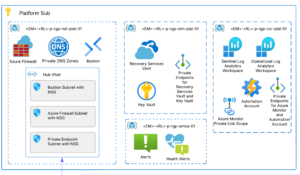Microsoft Azure Government DC is a group created for anyone in the IT world modernizing Government to bring real-world lessons to innovators in Government. AIS has supported and presented during these events since there were just five members. Now, the group is nearing 4,000. The July meetup focused on getting your agency to next-level cloud adoption with Microsoft Azure. Check out the recording and overview below.
Here’s What You Missed
Cloud Adoption has come a long way over the years. We have gone from a basic “lift and shift” model to migrating priority workloads to the cloud and optimizing for both high-security workloads and to tap into cloud-native services. If one thing is clear, hybrid capabilities are critical. It is important that we start thinking about the challenges as we start to move legacy IT infrastructure to the cloud. Two Microsoft Federal CTO’s, Susie Adams (Sales) and Kent Cunningham (Civilian), talk about changes Microsoft has been creating to simplify the migration processes. AIS Chief Technology Officer (CTO), Vishwas Lele, moderated a panel discussion with our customer, Richard Inzunza from Immigration and Customs Enforcement (ICE), who provided excellent insights around cloud adoption and his experience. The panel also included Jorge Gallardo, Program Manager from Peraton, who discusses his experience in regulated environments in the cloud.
Watch the Full Session:
Session Recap
Challenges when Migrating Workloads
Organizations can take their cloud adoption to the next level with Microsoft Azure when moving priority workloads in the cloud.
Microsoft breaks out the following based on maturity:
- Identity and Security
- DevOps and DevSecOps
- Data
- Cloud-Native
- The Edge
When organizations migrate their workloads to the cloud but have a diverse IT estate, it poses challenges to manage security, access to their data, and understanding where that data lives. As a result, Microsoft has brought tools and resources that customers need to easily manage their workloads and simplify the migration process in a multi-cloud world.
Many customers come with questions on how to implement and manage Infrastructure as a Service (IaaS) while meeting regulatory requirements like FedRAMP and HIPAA. Microsoft has a portal full of Azure Blueprints that allow organizations to select and deploy the chosen environment inside of their subscription. The goal? To simplify the deployment of these methods with peace of mind that they align with regulatory and compliance standards.
What Tools Can We Use to Simplify
Mission Landing Zones are highly opinionated templates that IT oversight organizations can configure or customize to quickly create a cloud management system. These are then deployed on Azure environments for their teams. Based on the Terraform platform, this will provide a secure, scalable landing zone for customer workloads. Mission Landing Zones enable expedited Cloud Adoption across Commercial, IL4, IL5, & IL6.
Customer’s environments are becoming increasingly complex, and Azure is helping organizations securely and efficiently move to the cloud by creating a single management experience for your entire environment. We recognize that companies are struggling with multiple different environments, and we are focusing on providing companies with granular access.
Azure Hybrid is a cost savings benefit that lets you bring your existing on-premises Windows Server and SQL Server licenses with active Software Assurance or subscriptions to Azure.
Azure Hybrid consists of the following:
- Azure Stack: A portfolio of products that extend Azure services and capabilities to your environment of choice – from datacenter to edge locations and remote offices.
- Azure Arc: Enables you to manage your entire environment, with a single pane of glass, by projecting your existing non-Azure, on-premises, or other cloud resources into Azure Resource Manager.
- Azure Internet of Things (IoT): A collection of Microsoft-managed cloud services that connect, monitor, and control billions of IoT assets hosted in the cloud.
- Azure Lighthouse: Facilitates a secure relationship between companies and their managed service providers while providing on-demand transparency into vendor access and actions.
Implementing Capabilities
With the release of the Cybersecurity Executive Order in May 2021, Microsoft is developing new ways to support and deploy these capabilities while meeting security and compliance standards.
- Enable security modernization: Help empower security teams to combat the increase in sophisticated attacks.
- Increase collaboration: Improve information sharing and security practices across public and private sector organizations.
- Deliver trusted and secure services: Build trust in government by securing information, improving software supply chain, and facilitating compliance.
Zero Trust architecture is based on the principle: never trust, always verify. This security approach protects customers by managing and granting access based on the continual verification of identities, devices, and services. Zero Trust architecture addresses challenges modern enterprises face. Microsoft Threat Protection powered by Azure is a comprehensive and seamless integration solution that provides end-to-end security for your organization using tools like Azure Sentinel and M365 functionalities. Learn more at https://aka.ms/cybereo.
Panel Discussion
A panel discussion was led by AIS CTO, Vishwas Lele. We were honored to have an AIS customer, Richard Inzunza, IT Specialist from the Department of Homeland Security speak on the panel. He was joined by Jorge Gallardo, Program Manager from Peraton.
Richard has been with the Federal Government for 36 years and with ICE since its inception in 2003. He has been a key player in the implementation of their hybrid cloud environment. ICE is in the process of building, extending, and expanding their ability to use cloud services from more than one service provider. AWS (Amazon Web Services) and Microsoft Azure are their biggest providers today, but their focus is to be able to take any valuable cloud service and integrate it into the ICE cloud to pass these capabilities onto their users and employees.
Common Challenges
There are several challenges Richard and ICE face in their line of work. Physical servers are no longer the main source for storing data, and helping customers understand the virtual aspect and how data is managed has been a challenge. Getting development teams and ITPMS, and other support teams to understand how to apply concepts of virtualization is extremely important for future development.
Many developers want to provision a capability without a true understanding of how this can open ICE to vulnerabilities. To address this ongoing challenge, they are helping their teams understand the responsibility level around cost and actions taken when provisioning new capabilities. Creating a vehicle that is compliant and future-proof is imperative for federal organizations to adapt and free time up for other key focuses. ICE’s goal is to get their teams to automate the delivery of their releases for their custom and third-party applications using pipelines.
Adjusting to a new virtual culture and applying security to a specific type of environment is a challenge that the assurance side of government IT is facing. ICE partnered with Peraton early on to align the implementation phase to begin their journey to the cloud. With this joint effort, three years later, ICE security teams are becoming more familiar with virtual environments at the beginning phase.
Ensuring Compliance
Policy Compliance & Security Compliance are a few types that ICE operates within. With their Policy, tagging is a method that ICE uses along with serverless LAMDA scripts to enforce compliance. They also have databases that store the tag values for valid metadata that correlates with an infrastructure or application. Ensuring that type of policy compliance helps at the management and administration level to understand the information they pull is accurate and helpful in many ways.
Security Compliance is now managed with advanced scanning tools and different checks to ensure when a policy has been adjusted. With accurate scanning, Richard is notified when policies have been adjusted and can reach out to the appropriate network to validate.
AIS: Your Trusted Azure Partner
We help government organizations create cohesive multi-cloud strategies, bringing the expertise you require for successful cloud adoption, modernization, data intelligence, and beyond. At AIS, we help you take a step back and look at the requirements needed and what services can be used with Azure or other tools to meet needs, offering templates and support for documentation. Our scalable cloud solutions address our clients’ most complex concerns, with deep experience across national security and military operations, as well as Federal, State, and Local Governments and their supporting agencies. We have been working with Azure for 12+ years and will have you well on your way to realizing the best that the cloud can offer.
Join us for future virtual meetings at the Microsoft Azure Government User Community: https://www.meetup.com/dcazuregov/.






